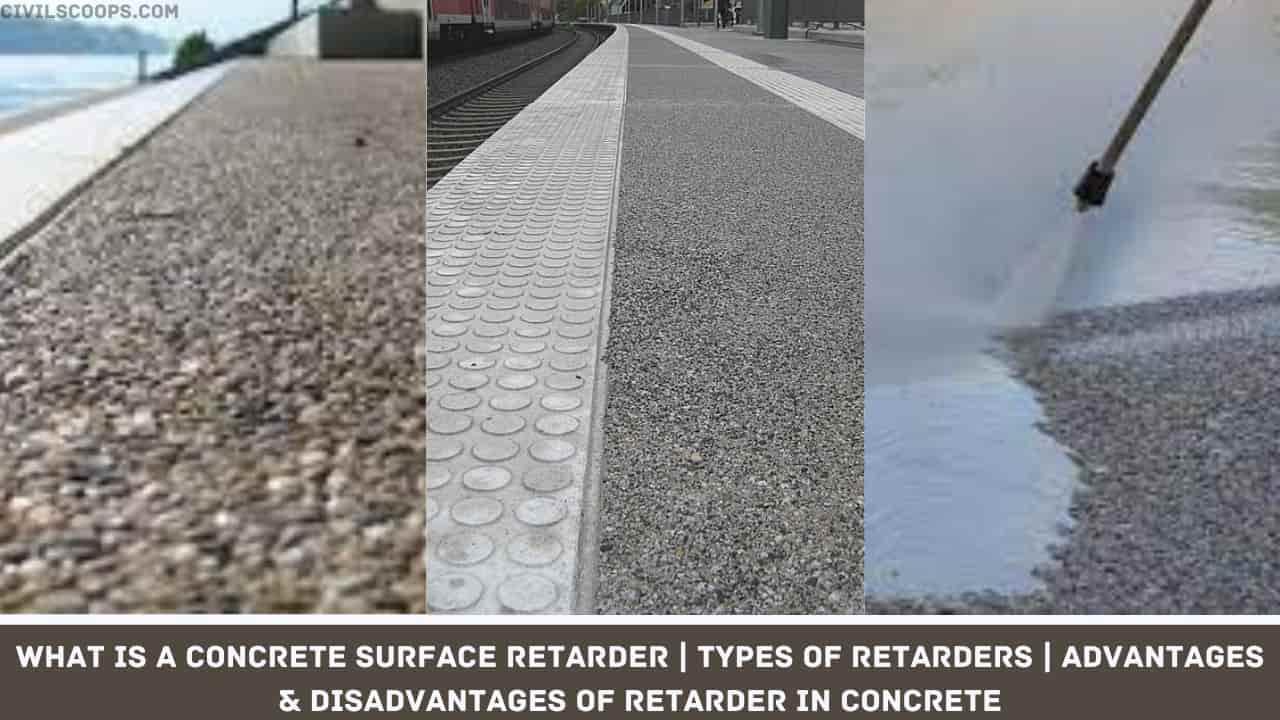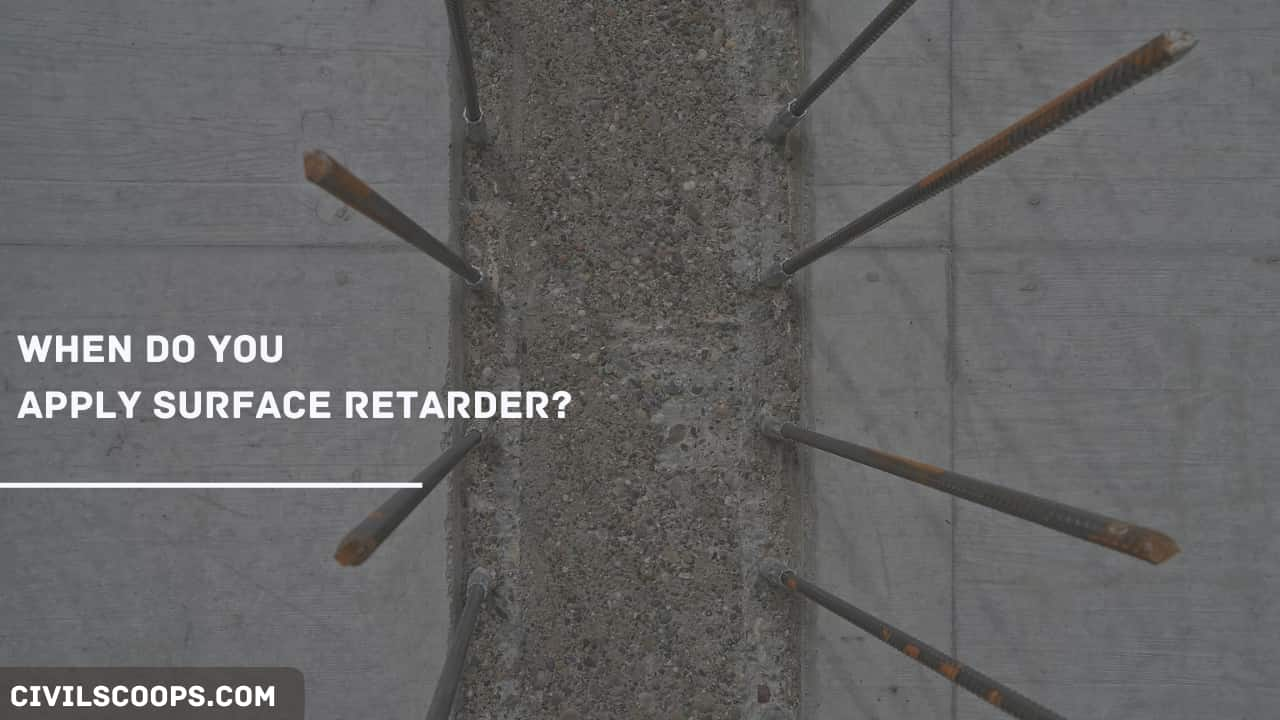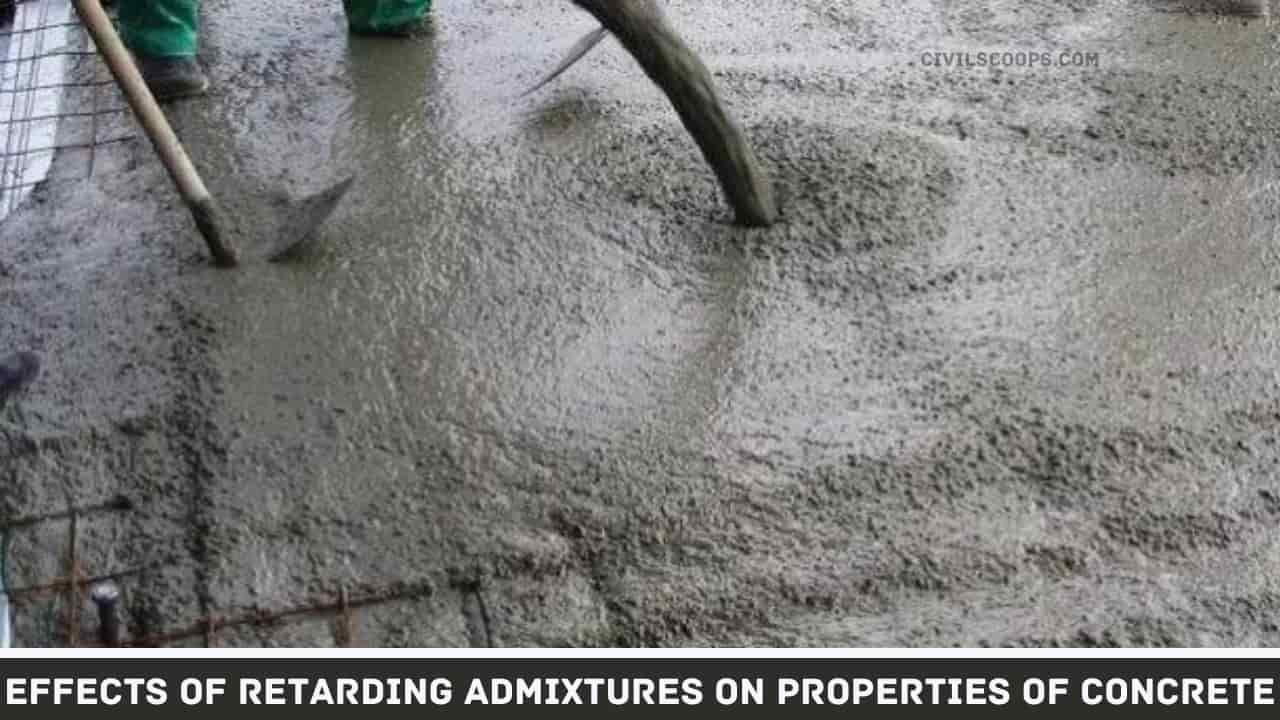What Is a Concrete Surface Retarder | Types of Retarders | Advantages & Disadvantages of Retarder in Concrete

Table of Contents
What Is a Concrete Surface Retarder?
Surface retarders, also know surface “deactivators,” are applied to fresh concrete to chemically delay the set of the surface mortar. Unlike concrete set retarders, they allow the rest of the concrete to cure normally, without affecting the setting rate or strength gain.
Because surface retarders work their magic by stopping the hydration process down to a controlled depth, the underlying concrete will harden properly while allowing easy removal of this surface paste later.
Whenever you’re ready to expose the aggregate by hosing or high-pressure washing, the depth of aggregate reveal is more uniform with minimal pop-outs.
When Do You Apply Surface Retarder?

The best time to apply surface retarder is after you have completed all finishing operations and the bleed water has dissipated. Do not seal the concrete first or apply curing compounds, which might prevent the retarder from doing its job.
Apply surface retarder evenly over the surface using a low-pressure sprayer or roller. Many surface retarders are designed to form a film over the surface which acts as a temporary curing agent and protects the concrete from mild wind and rain. But if extreme wind or rain is expected, you need to protect the surface with plastic sheeting.
Related Articale
- What Is Fresh Concrete | 8 Properties of Fresh Concrete
- What Is Bleeding In Concrete | What Is Segregation In Concrete
- What Is Self Compact Concrete | What Is Slump Flow Test | Equipment for Slump Flow Test | Procedure of Slump Flow Test
- What Is Concrete Resurfacing | How to Resurface Concrete | Concrete Resurfacing Material | Concrete Repair and Resurfacing
- Is Steel Stronger Than Concrete | Steel and Concrete Construction Costs | Steel Vs Concrete | How Strong Is Concrete | Concrete Vs Steel Building Cost
Types of Retarders
Retarders are divided into 2 categories depending on the nature of the retarders, they are
1. Organic Retarders
- Phosphonates
- Sugars
- Lignosulphonates
- Hydroxycarboxylic acids and their salts
2. Inorganic or Chemical Retarders
- Salts of Pb, Zn, Cu, As, Sb
- Phosphonates
- Borates
Also Read: Difference Between Cement Plaster and Gypsum Plaster
Effects of Retarding Admixtures on Properties of Concrete

Here, the effects of retarding admixtures on properties of concrete are as follows.
- Strength
- Bleeding
- Durability
- Slump Loss
- Workability and Rheological Values
- Heat of Hydration
- Air Entrainment
- Freeze-Thaw Cycles
- Volume Deformation
Let’s know about detail knowledge for effects of retarding admixtures on properties of concrete are as follows.
- Strength: The initial compressive strength of concrete into that retarding admixtures are added is lower than the compressive strength of a similar concrete that wasn’t treated with retarding admixtures.
- Bleeding: Since retarding admixtures delay the beginning of the setting process, retarded concretes are always more likely to bleed.
- Durability: If concrete is correctly cured, retarded concrete needs to be just as durable as equivalent plain concrete.
- Slump Loss: Retarding admixtures have been shown to be very effective in reducing slump loss and in this way increasing the initial workability.
- Workability and Rheological Values: Retarding admixtures have a small effect on the workability of concrete. They could cause an increase of initial slump by 60-100mm.
- Heat of Hydration: Retarding admixtures don’t reduce the heat output of concrete however delay the rise of the peak temperatures by a time interval much like the one where the concrete was retarded.
- Air Entrainment: Retarding admixtures do not normally entrain air but there are some kinds of retarders that do. Especially these based on hydroxycarboxylic acid can actually reduced air content.
- Freeze-Thaw Cycles: Air entraining admixtures are often utilized to improve the freeze-thaw resistance of concrete. After the water from the concrete starts freezing, the air cells function as microscopic expansion chambers to the freezing water.
- Volume Deformation: Creep and drying shrinkage isn’t significantly affected by the inclusion of retarding admixtures but plastic shrinkage might be slightly increased.
Advantages of Retarder in Concrete
Considered a boon for the construction Procedure, in the long run, concrete retarders Help with multiple advantages and a Few major advantages are being discussed below for your reference,
- Retarding admixtures extend the setting time of concrete and maintain the workability and cohesion for an extended period of time.
- From the large construction projects, concrete retarder prevents cold joints formation in successive lifts and make concretely workable through concrete placing.
- With the usage of concrete retarders, you can compensate for the accelerating effect of high temperature towards the initial setting time and minimize risks of long-distance delivery in warm weather.
- The usage of retarding admixtures improves the permeability of concrete by delayed setting period and improved workability of concrete.
- Concrete retarders help to reduce segregation and bleeding in concrete where poor sand grading is unavoidable.
Disadvantages of Concrete Retarders
Everything has a slice of precautions or you may say disadvantages. The same stands true in the event of concrete retarders.
Laid below are a few common disadvantages that you ought to know about before using concrete retarders for your construction process.
- The concrete retarders may be employed with water-reducers however care needs to be taken while curing to avoid bleeding and cracks.
- The dosage of retarding admixtures must be within limits based upon its water-cement ratio, cement content, and amount of C3A from the cement.
- Use of gypsum as a retarding admixture for the purpose of retarding setting time is recommended when adequate control and inspection can be obtained, otherwise, the addition of excess amount can cause undesirable expansion and an indefinite delay in the setting of concrete.
- Concrete retarders could have variable action on different kinds of cement when used in different quantities.
Uses of Concrete Retarders
Concrete retarders are abundantly used or applied in various construction settings; however, some most popular uses or applications are given over here,
- Retarding admixtures are most commonly used in hot weather concreting.
- Retarder sprayed to the surface of the formwork to prevent the hardening of this matrix in the interface of concrete and formwork, whereas the rest of the concrete gets.
- Retarders are utilized for large or massive construction work hardened.
- Retarding admixtures are used in grouting oil wells.
[su_box title=”FAQ” style=”default” box_color=”#333333″ title_color=”#FFFFFF” radius=”3″ class=”” id=””]
Retarders in Concrete
Retarding admixtures, which slow the setting rate of concrete, are used to counteract the accelerating effect of hot weather on concrete setting. Retarders keep concrete workable during placement and delay the initial set of concrete. Most retarders also function as water reducers and may entrain some air in concrete.
What Is Retarder in Concrete?
Retarding admixtures are used to slow the rate of setting of concrete. By slowing the initial setting time, the concrete mixture can stay in its fresh mix state longer before it gets to its hardened form. Use of retarders is beneficial for: Complex concrete placement or grouting.
Surface Retarder
W. R. MEADOWS’ surface retarders are spray-applied, water-soluble products designed to slow the set of surface mortar in concrete to expose the aggregate. These products temporarily halt the set of Portland cement at the surface while the concrete below the surface cures normally.
Concrete Retarder Admixture
Retarding admixtures, which slow the setting rate of concrete, are used to counteract the accelerating effect of hot weather on concrete setting. High temperatures often cause an increased rate of hardening which makes placing and finishing difficult.
Concrete Set Retarder
Set retarder refers to the admixture that can delay the setting time of concrete mixing materials, and have no bad impact on the development of concrete’s latter strength. It often contains lignosulfonate, carbohydrate, inorganic salts and organic acids. The most common ones are calcium lignosulfonate and molasses.
Concrete Surface Retarder
Surface retarders allow concrete finishers to add decorative architectural finishes to horizontal concrete surfaces, such as exposed aggregate. They can also be used for creating an appropriate bonding surface for other materials or concrete layers.
What Is Concrete Retarder Made of?
Retarders for use on forms or concrete surfaces are likely to be made up of such substances as sugars, dextrins, hydroxylated carboxylic acids or their salts, or lignosulfonates, the same classes of materials used in retarding admixtures.
Concrete Surface Deactivator
Surface Deactivator creates a polymeric flim that acts as a water retention barrier and temporary curing agent, protecting fresh concrete from light rain and reducing moisture loss. Surface Deactivator can be applied to newly-placed concrete that is specified for diamond polishing.
Disadvantages of Retarders in Concrete
The use of retarding admixture has the main drawback of the possibility of rapid stiffening, where rapid slump loss will result in difficulty of concrete placement, consolidation, and finishing.
Examples of Retarders in Concrete
Commonly used retarding admixture is calcium sulphate or gypsum. Starch, cellulose products, common sugar, salts of acids are some other retarders. Most of water reducing admixtures are also acts as retarding admixtures and they are called as retarding plasticizers.
[/su_box]
[su_note note_color=”#F2F2F2 ” text_color=”#333333″ radius=”3″ class=”” id=””]
Like this post? Share it with your friends!
Suggested Read –
- Procedure for RCC Concrete
- Testing for Silt Content in Sand
- What Is Bleeding In Concrete | What Is Segregation In Concrete
- What Is Sand Blasting | Concrete Sand-blasting Equipment | Key Benefits of Sand Blasting
- What Is Pedestal | Functions of Pedestal | Methods of Construction: Pedestals | Advantages and Disadvantages of Pedestal
[/su_note]
Originally posted 2022-07-17 13:08:59.
